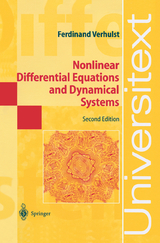Nonlinear Differential Equations and Dynamical Systems
Springer Berlin (Verlag)
978-3-540-60934-6 (ISBN)
Ferdinand Verhulst was born in Amsterdam, The Netherlands, in 1939. He graduated at the University of Amsterdam in Astrophysics and Mathematics. A period of five years at the Technological University of Delft, started his interest in technological problems, resulting in various cooperations with engineers. His other interests include the methods and applications of asymptotic analysis, nonlinear oscillations and wave theory. He holds a chair of dynamical systems at the department of mathematics at the University of Utrecht. Among his other interests are a publishing company, Epsilon Uitgaven, that he founded in 1985, and the relation between dynamical systems and psychoanalysis. For more information see www.math.uu.nl/people/verhulst
1 Introduction.- 1.1 Definitions and notation.- 1.2 Existence and uniqueness.- 1.3 Gronwall's inequality.- 2 Autonomous equations.- 2.1 Phase-space, orbits.- 2.2 Critical points and linearisation.- 2.3 Periodic solutions.- 2.4 First integrals and integral manifolds.- 2.5 Evolution of a volume element, Liouville's theorem.- 2.6 Exercises.- 3 Critical points.- 3.1 Two-dimensional linear systems.- 3.2 Remarks on three-dimensional linear systems.- 3.3 Critical points of nonlinear equations.- 3.4 Exercises.- 4 Periodic solutions.- 4.1 Bendixson's criterion.- 4.2 Geometric auxiliaries, preparation for the Poincaré-Bendixson theorem.- 4.3 The Poincaré-Bendixson theorem.- 4.4 Applications of the Poincaré-Bendixson theorem.- 4.5 Periodic solutions in ?n.- 4.6 Exercises.- 5 Introduction to the theory of stability.- 5.1 Simple examples.- 5.2 Stability of equilibrium solutions.- 5.3 Stability of periodic solutions.- 5.4 Linearisation.- 5.5 Exercises.- 6 Linear Equations.- 6.1 Equations with constant coefficients.- 6.2 Equations with coefficients which have a limit.- 6.3 Equations with periodic coefficients.- 6.4 Exercises.- 7 Stability by linearisation.- 7.1 Asymptotic stability of the trivial solution.- 7.2 Instability of the trivial solution.- 7.3 Stability of periodic solutions of autonomous equations.- 7.4 Exercises.- 8 Stability analysis by the direct method.- 8.1 Introduction.- 8.2 Lyapunov functions.- 8.3 Hamiltonian systems and systems with first integrals.- 8.4 Applications and examples.- 8.5 Exercises.- 9 Introduction to perturbation theory.- 9.1 Background and elementary examples.- 9.2 Basic material.- 9.3 Naïve expansion.- 9.4 The Poincaré expansion theorem.- 9.5 Exercises.- 10 The Poincaré-Lindstedt method.- 10.1 Periodic solutions of autonomous second-order equations.- 10.2 Approximation of periodic solutions on arbitrary long time-scales.- 10.3 Periodic solutions of equations with forcing terms.- 10.4 The existence of periodic solutions.- 10.5 Exercises.- 11 Themethod of averaging.- 11.1 Introduction.- 11.2 The Lagrange standard form.- 11.3 Averaging in the periodic case.- 11.4 Averaging in the general case.- 11.5 Adiabatic invariants.- 11.6 Averaging over one angle, resonance manifolds.- 11.7 Averaging over more than one angle, an introduction.- 11.8 Periodic solutions.- 11.9 Exercises.- 12 Relaxation Oscillations.- 12.1 Introduction.- 12.2 Mechanical systems with large friction.- 12.3 The van der Pol-equation.- 12.4 The Volterra-Lotka equations.- 12.5 Exercises.- 13 Bifurcation Theory.- 13.1 Introduction.- 13.2 Normalisation.- 13.3 Averaging and normalisation.- 13.4 Centre manifolds.- 13.5 Bifurcation of equilibrium solutions and Hopf bifurcation.- 13.6 Exercises.- 14 Chaos.- 14.1 Introduction and historical context.- 14.2 The Lorenz-equations.- 14.3 Maps associated with the Lorenz-equations.- 14.4 One-dimensional dynamics.- 14.5 One-dimensional chaos: the quadratic map.- 14.6 One-dimensional chaos: the tent map.- 14.7 Fractal sets.- 14.8 Dynamical characterisations of fractal sets.- 14.9 Lyapunov exponents.- 14.10 Ideas and references to the literature.- 15 Hamiltonian systems.- 15.1 Introduction.- 15.2 A nonlinear example with two degrees of freedom.- 15.3 Birkhoff-normalisation.- 15.4 The phenomenon of recurrence.- 15.5 Periodic solutions.- 15.6 Invariant tori and chaos.- 15.7 The KAM theorem.- 15.8 Exercises.- Appendix 1: The Morse lemma.- Appendix 2: Linear periodic equations with a small parameter.- Appendix 3: Trigonometric formulas and averages.- Appendix 4: A sketch of Cotton's proof of the stable and unstable manifold theorem 3.3.- Appendix 5: Bifurcations of self-excited oscillations.- Appendix 6: Normal forms of Hamiltonian systems near equilibria.- Answers and hints to the exercises.- References.
| Erscheint lt. Verlag | 6.9.1996 |
|---|---|
| Reihe/Serie | Universitext |
| Zusatzinfo | X, 306 p. 2 illus. |
| Verlagsort | Berlin |
| Sprache | englisch |
| Maße | 155 x 235 mm |
| Gewicht | 490 g |
| Themenwelt | Mathematik / Informatik ► Mathematik ► Analysis |
| Mathematik / Informatik ► Mathematik ► Differentialgleichungen | |
| Naturwissenschaften ► Physik / Astronomie | |
| Schlagworte | adopted-textbook • averaging methods • Bifurcation Theory • Chaos • Differential Equations • Differenzialgleichungen • Dynamical Systems • Dynamisches System • Dynamische Systeme • Hardcover, Softcover / Mathematik/Analysis • HC/Mathematik/Analysis • Nonlinear Systems • oscillations |
| ISBN-10 | 3-540-60934-2 / 3540609342 |
| ISBN-13 | 978-3-540-60934-6 / 9783540609346 |
| Zustand | Neuware |
| Haben Sie eine Frage zum Produkt? |
aus dem Bereich




